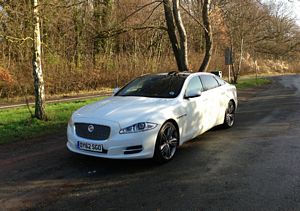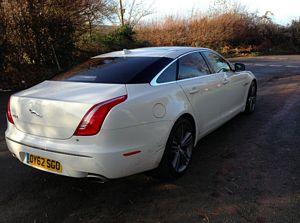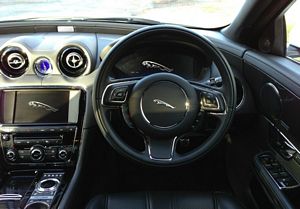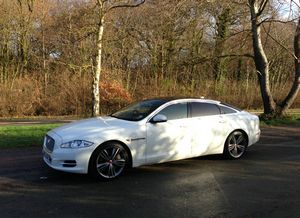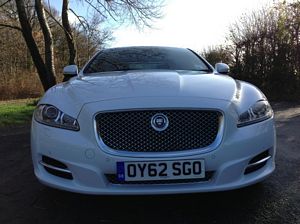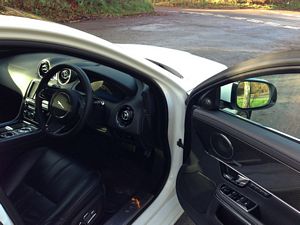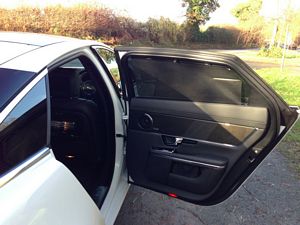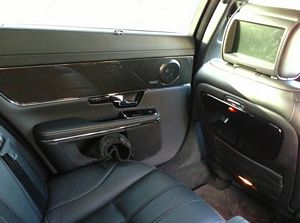|
By accessing or using The Crittenden Automotive Library™/CarsAndRacingStuff.com, you signify your agreement with the Terms of Use on our Legal Information page. Our Privacy Policy is also available there. |

Jaguar XJ Supersport L review
|
|---|
|
|
Jaguar XJ Supersport L review
Matt Hubbard
Speedmonkey
December 8, 2012
Matt Hubbard reviews the Jaguar XJ 5.0 Supersport, the biggest and most luxurious model in the Jaguar range
The Jaguar XJ has been around, in name at least, since 1968. The shape of the car changed little from the original Series 1 through to 2009 when the last X358 rolled off the production line. Over those 41 years the XJ changed under the skin but, like the Porsche 911, the basic silhouette remained true to form.
In July 2009 Jaguar revealed the new XJ, created by über talented designer Ian Callum (if you've never heard of him he's the Adrian Newey of the road car design world). The new XJ was a complete redesign and a wholly different car from it's predecessor. And it was better in every way.
I recently tested the Supersport, long wheel base version of the XJ. It costs £95,253 and is powered by Jaguar's seminal 5 litre, supercharged engine.
Old XJs adopted the reverse TARDIS approach to interior space. On the outside they are big cars but clamber inside and all the space taken up by the car seems to shrink so the occupants are hemmed in by vast amounts of leather and walnut.
The new XJ is a big car, and the long wheelbase version is huge, on the outside. On the inside it feels as though it's even bigger than it looks from the outside. It's vast. And it's a lovely place to be. The Supersport version is trimmed in black leather, piano black wood, aluminium and carbon fibre.
Plush is too small a word for how luxurious it is. The back seats are an even more spacious, and comfortable place to be, than the front. Pull down the centre arm rest, stretch your legs, pull out a drink from the fridge, watch TV, don your headphones, pull up the window blind. The back seat of the XJ is even more commodious and accommodating than a first class seat with Virgin Atlantic.
The dash is blank until the Start button is pressed, whereupon three dials (speed, revs and other information) pop up in front of you. Mercedes S Class uses a similar system and, to be honest, it isn't really necessary and doesn't benefit the driver.
Fire up the familiar 5 litre engine and it sits at tick over-exuding a low V8 rumble. Pull away and the rumble turns to a roar. The engine note is less deliriously over the top than in the XKR-S but it seems to be slightly louder than the same unit in the XFR.
In fact when the throttle pedal is pressed the engine noise sounds like a bull elephant trumpeting over your shoulder. At one point I pulled into a lay-by and a farmer who had been following shouted out of his window, "By 'eck that sounds good." He was correct. It does.
The 503bhp engine is the same as in the XFR and I found that overwhelmed the car, although enjoyably so. In the larger, heavier XJ, the engine suits the car perfectly. Power is delivered instantly and the 8 speed automatic gearbox changes in an instant. Huge speeds are achieved quickly and quietly. Dollops of power, if applied too enthusiastically, can overcome traction and the back wheels skitter out, only to be brought back into line by the ESC.
The ride is of magic carpet proportions. The steering is light but gives just about enough feedback. Inevitably for such a huge car handling is somewhat removed from the driver. If you want to feel the road, the XJ is not for you. But then again that's not the point of it. It is, though and with the above taken into account, a surprisingly good car to drive. Look over your left shoulder and the rear window looks, and is, a massive distance away. Yet you don't ever feel like you are lugging1900kg of car around. It treads the fine line between achieving a comfortable ride, and having at least some handling, well.
The bodywork of the Jaguar is not what you would call beautiful. It is elegant, though. The front end uses the modern Jaguar grille, which looks good - however the shutline around the nose is unfortunately placed. The rear of the car is unconventional with no crease or spoiler to distinguish the changeover between the horizontal boot and the vertical rear of the car. It would look better in a darker colour than the white version I drove. The XJ is big and the shape and lines don't disguise this fact; more they highlight, almost celebrate, it's size.
After having driven the Mercedes S 65 AMG L earlier this year, I'd say the XJ Supersport is the better car. The Jaguar isn't quite as quiet. The Mercedes' V12 is almost silent and the double glazed windows block out almost all outside noise, whereas the Jaguar's engine trumpets away and the windows are thick, but not double glazed.
The Mercedes costs £172,000 against the Jaguar's £95,000. I don't see £77,000 worth of difference. The Jaguar is better to drive, has better and more comfortable rear seats and has all the toys anyone would ever need - and does it all with less effort. The Mercedes' elegance feels more forced and manufactured than Jaguars natural refinement - and that is down to the genius of Ian Callum.
The Jaguar XJ deserves it's place amongst the great cars. It deserves to be known as the Jaguar that broke the mould after 40 years of same same. It is a fantastic car.

















